Birds
One of great attraction of Mt. Takao is to be able to observe all kinds of birds. Its number is almost 150 kinds which is one third of the species confirmed in all over Japan. Mt. Takao is the paradise for birds and one of the best place for bird watching. Various kinds of birds and its lifestyle could be observed including summer birds come in spring time, winter birds come from the higher altitude and hearing beautiful bird songs during breeding season.
-
Cinclus pallasii (Brown Dipper) Brown Dipper
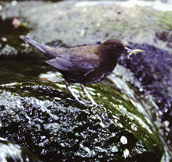
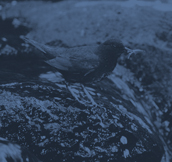 Cinclus pallasii (Brown Dipper) Brown Dipper
Cinclus pallasii (Brown Dipper) Brown Dipper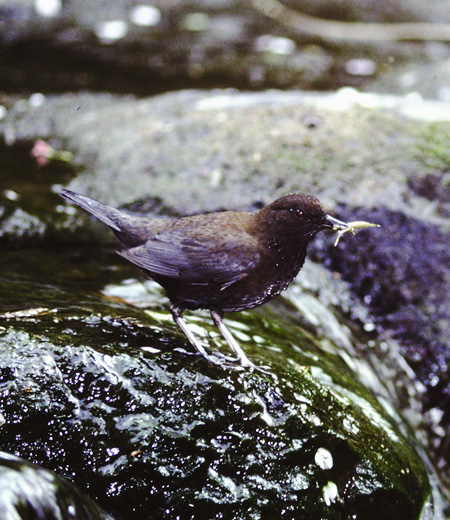 Live in clear streams in mountains. Although there is a word “crow” in the Japanese name but they are not closely related species. Live alone except breeding season and hold territory. Fly close to the water surface while chirping “pi”. Rest on rocks or driftwoods with their wings half-opened and tails moving upward and downward repeatedly. Have short and dumpy body with thick legs. Walk in the water and progress like swimming towards upsteam and hunt for aquatic insects including trichoptera or plecoptera and small fish. The breeding season is from Feburary to June, earlier than other species. Build a nest with moss at short falls or dips between rocks in a dam. Lay four to six eggs in a season.
Live in clear streams in mountains. Although there is a word “crow” in the Japanese name but they are not closely related species. Live alone except breeding season and hold territory. Fly close to the water surface while chirping “pi”. Rest on rocks or driftwoods with their wings half-opened and tails moving upward and downward repeatedly. Have short and dumpy body with thick legs. Walk in the water and progress like swimming towards upsteam and hunt for aquatic insects including trichoptera or plecoptera and small fish. The breeding season is from Feburary to June, earlier than other species. Build a nest with moss at short falls or dips between rocks in a dam. Lay four to six eggs in a season.
●Body Length about 22 cm
●Season January to December (resident bird, bird that stay in the same area all year round.) -
Turdus dauma (White’s ground thrush) Blue-and-white Flycatcher
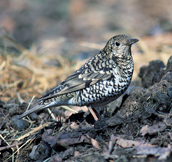
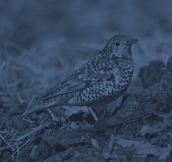 Turdus dauma (White’s ground thrush) Blue-and-white Flycatcher
Turdus dauma (White’s ground thrush) Blue-and-white Flycatcher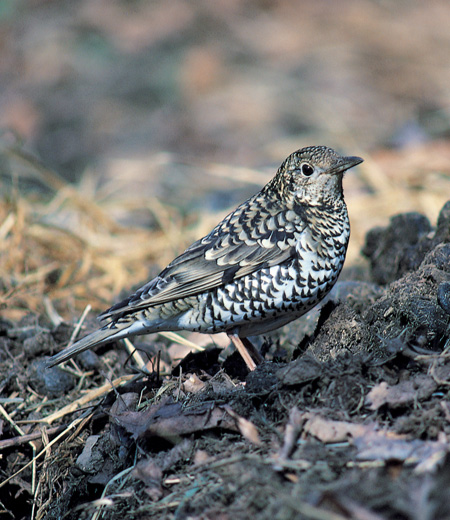 Is the largest thrush live in Japan. Each feather has black edged yellow and the entire wing resembling patterns like tigers, hence the Japanese name tora-tsugumi literally meaning tiger thrush. Always live in dark forests and walk and jump around to flip fallen leaves upside down and hunt for insects, earthworms and snails. When sensing dangers, rest on tree branches and stand still. Chirp like whistles around midnight. The breeding season is from April to July. Build a nest with moss and pine leaves on a crotch of tree. Lay four to five eggs in a season.
Is the largest thrush live in Japan. Each feather has black edged yellow and the entire wing resembling patterns like tigers, hence the Japanese name tora-tsugumi literally meaning tiger thrush. Always live in dark forests and walk and jump around to flip fallen leaves upside down and hunt for insects, earthworms and snails. When sensing dangers, rest on tree branches and stand still. Chirp like whistles around midnight. The breeding season is from April to July. Build a nest with moss and pine leaves on a crotch of tree. Lay four to five eggs in a season.
●Body Length about 30 cm
●Season January to December (resident bird, bird that stay in the same area all year round, and wandering bird, bird that have different areas for breeding and spending winter)(未翻訳)鳴き声を聞く
-
Turdus pallidus (Pale Thrush) Blue-and-white Flycatcher
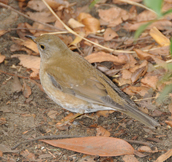
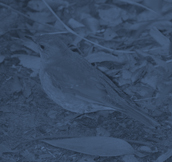 Turdus pallidus (Pale Thrush) Selected
Turdus pallidus (Pale Thrush) Selected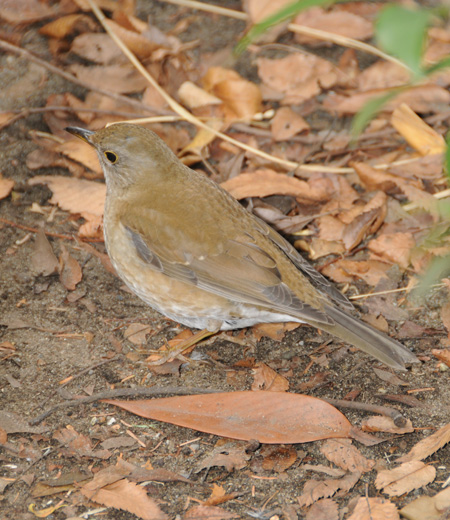 Is a winter bird fly to Japan to spent winter and native to areas in Ussuri river runs on the border of northeastern China and Russia and Korean Penninsula. Live in forests from flatlands to mountains and also at woody parks and fruit farms. Walk and jump around shady forests and hardly ever come out to open spaces. Hunt for earthworms and larvae from the fallen leaves layers and soils. The body color of male and female is almost the same and gray on the head and dark-greenish dark brown on the back. Gray on abdomen with distinct white center as the Japanese name Shirohara literally meaning white abdomen states. Chirp sounding like “cyo cyo cyo” and “twee” when they are about to fly. Fly back north in spring but some breed in Tsushima in Nagasaki prefecture.
Is a winter bird fly to Japan to spent winter and native to areas in Ussuri river runs on the border of northeastern China and Russia and Korean Penninsula. Live in forests from flatlands to mountains and also at woody parks and fruit farms. Walk and jump around shady forests and hardly ever come out to open spaces. Hunt for earthworms and larvae from the fallen leaves layers and soils. The body color of male and female is almost the same and gray on the head and dark-greenish dark brown on the back. Gray on abdomen with distinct white center as the Japanese name Shirohara literally meaning white abdomen states. Chirp sounding like “cyo cyo cyo” and “twee” when they are about to fly. Fly back north in spring but some breed in Tsushima in Nagasaki prefecture.
●Body Length about 25 cm
●Season November to March (Winter bird, fly to Japan in autumn and spend winter and fly away in spring.) -
Turdus chrysolaus (Brown Thrush) Blue-and-white Flycatcher
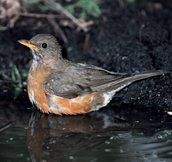
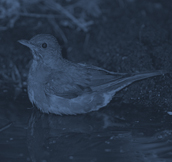 Turdus chrysolaus (Brown Thrush) Blue-and-white Flycatcher
Turdus chrysolaus (Brown Thrush) Blue-and-white Flycatcher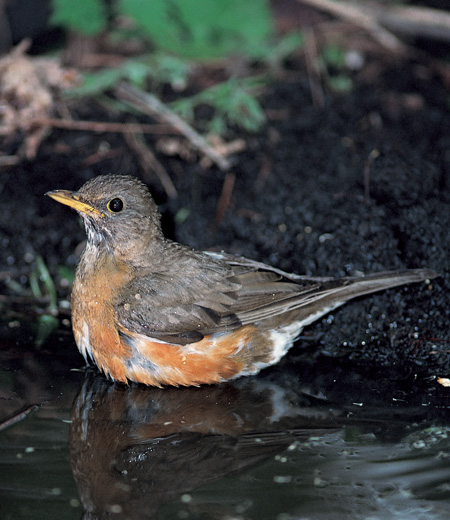 Change habitats depending on season. Fly to Mt. Takao from winter. The body color of male and female is almost the same and black on the head and distinct bright orange feathers from chest to side of abdomen. Prefer to live in bright needle-leaved forests with larches from flatlands to mountains. Walk and jump around to hunt for earthworms and larvae by picking soils and also feed on nuts of trees. The breeding season is from May to August. Male chirp beautifully sounding like “quiolon quiolon chee”. Build a cup-shaped nest with fallen plants and moss on vine-twined branches or tilt placed fallen trees. Lay three to five eggs in a season. In winter, come down to flatlands including parks in cities and then fly to warmer areas or Southeast Asia.
Change habitats depending on season. Fly to Mt. Takao from winter. The body color of male and female is almost the same and black on the head and distinct bright orange feathers from chest to side of abdomen. Prefer to live in bright needle-leaved forests with larches from flatlands to mountains. Walk and jump around to hunt for earthworms and larvae by picking soils and also feed on nuts of trees. The breeding season is from May to August. Male chirp beautifully sounding like “quiolon quiolon chee”. Build a cup-shaped nest with fallen plants and moss on vine-twined branches or tilt placed fallen trees. Lay three to five eggs in a season. In winter, come down to flatlands including parks in cities and then fly to warmer areas or Southeast Asia.
●Body Length about 24 cm
●Season November to March (wandering bird, bird that have different areas for breeding and spending winter)(未翻訳)鳴き声を聞く
-
Turdus naumanni (Dusky Thrush) Blue-and-white Flycatcher
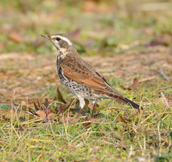
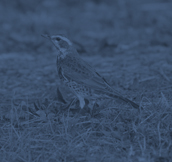 Turdus naumanni (Dusky Thrush) Selected
Turdus naumanni (Dusky Thrush) Selected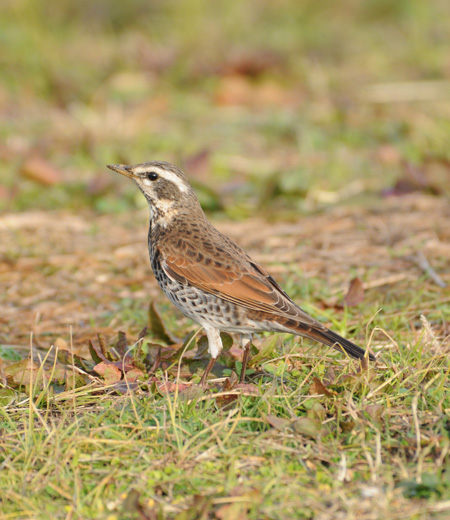 Come back to Japan in autumn in a large group from breeding ground in Siberia to spent winter. Spread throughout Japan and live in forests, croplands, riverbeds and parks and even at feeding stations at residence. Roost in woody forests and shrubs and live in a group right after they arrive Japan but most of them live alone in winter. Jump and walk on the ground and stop with holding their chest out. This species repeat these actions and hunt for preys. Feed on earthworms and larvae from picking them from fallen leaves and soils. Also feed on fruits of persimmons and pyracantha. In autumn, chirp sounding like “cu cu” repeatedly and “twee” while flying. Are in a group again in spring to go back north for breeding.
Come back to Japan in autumn in a large group from breeding ground in Siberia to spent winter. Spread throughout Japan and live in forests, croplands, riverbeds and parks and even at feeding stations at residence. Roost in woody forests and shrubs and live in a group right after they arrive Japan but most of them live alone in winter. Jump and walk on the ground and stop with holding their chest out. This species repeat these actions and hunt for preys. Feed on earthworms and larvae from picking them from fallen leaves and soils. Also feed on fruits of persimmons and pyracantha. In autumn, chirp sounding like “cu cu” repeatedly and “twee” while flying. Are in a group again in spring to go back north for breeding.
●Body length about 24 cm
●Season October to April (Winter bird, fly to Japan in autumn and spend winter and fly away in spring.) -
Erithacus cyane (Siberian Blue Robin) Blue-and-white Flycatcher
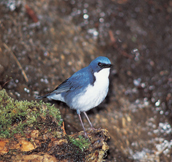
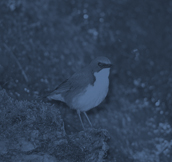 Erithacus cyane (Siberian Blue Robin) Blue-and-white Flycatcher
Erithacus cyane (Siberian Blue Robin) Blue-and-white Flycatcher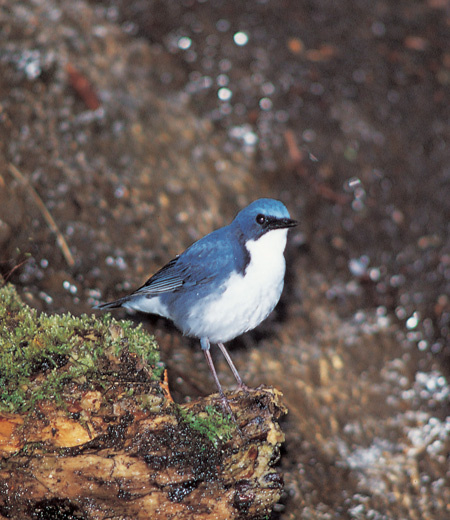 Come back to Japan from Southeast Asia where they spent winter and spring. The body color for male is dark blue head to the back and white abdomen and female is greenish brown on entire body. Found in low elevations up to 1,500 meters elevations. Live in broad-leaved forests with Japanese zelkova. Live alone or in pairs and hold territory. Hunt for insects, spiders and earthworms. The breeding season is from May to July and chirp sounding like “che che che”. Build a cup-shaped nest with palm leaves and fallen twigs on the ground near fallen trees. Lay four to six eggs in a season. Fly back to southern China and Indocine peninsula.
Come back to Japan from Southeast Asia where they spent winter and spring. The body color for male is dark blue head to the back and white abdomen and female is greenish brown on entire body. Found in low elevations up to 1,500 meters elevations. Live in broad-leaved forests with Japanese zelkova. Live alone or in pairs and hold territory. Hunt for insects, spiders and earthworms. The breeding season is from May to July and chirp sounding like “che che che”. Build a cup-shaped nest with palm leaves and fallen twigs on the ground near fallen trees. Lay four to six eggs in a season. Fly back to southern China and Indocine peninsula.
●Body Length about 14 cm
●Season April to October (Summer bird, fly to one area from spring to summer for breeding and fly back to southern areas in autumn.)(未翻訳)鳴き声を聞く
-
Tarsiger cyanurus (Siberian Bluechat) Blue-and-white Flycatcher
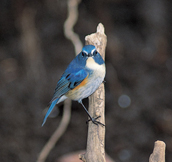
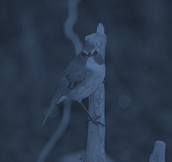 Tarsiger cyanurus (Siberian Bluechat) Selected
Tarsiger cyanurus (Siberian Bluechat) Selected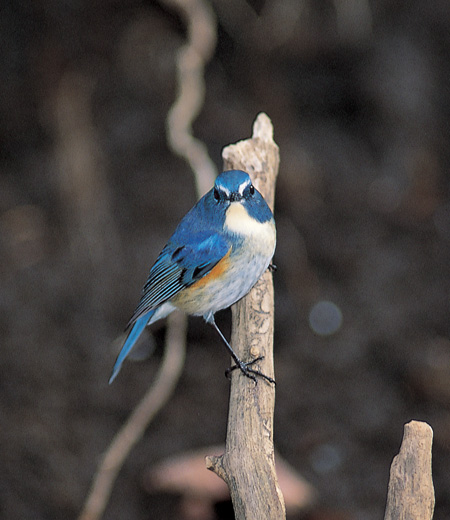 Male’s blue feathers from the head to the tail are very beautiful with striking orange on the side of abdomen. The body color of female is greenish brown on entire body. Change habitat on season and live in 1,500 meters high elevation areas from spring to summer for breeding and come down to low elevations including forests in Mt. Takao and woody parks in winter. Live alone and both male and female hold territory. Hunt for insects, centipedes and spiders and feed on nuts of trees in winter. The breeding season is from June to August. Male rest on higher branches and chirp sounding like “pi chuli hyo lo lo”. Build a cup-shaped nest with moss and fallen leaves at the root of fallen trees. Lay three to five eggs in a season.
Male’s blue feathers from the head to the tail are very beautiful with striking orange on the side of abdomen. The body color of female is greenish brown on entire body. Change habitat on season and live in 1,500 meters high elevation areas from spring to summer for breeding and come down to low elevations including forests in Mt. Takao and woody parks in winter. Live alone and both male and female hold territory. Hunt for insects, centipedes and spiders and feed on nuts of trees in winter. The breeding season is from June to August. Male rest on higher branches and chirp sounding like “pi chuli hyo lo lo”. Build a cup-shaped nest with moss and fallen leaves at the root of fallen trees. Lay three to five eggs in a season.
●Body Length about 14 cm
●Season November to March (wandering bird, bird that have different areas for breeding and spending winter)(未翻訳)鳴き声を聞く
-
Phoenicurus auroreus (Daurian Redstart) Blue-and-white Flycatcher
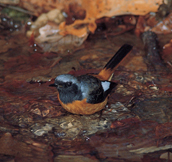
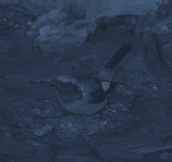 Phoenicurus auroreus (Daurian Redstart) Selected
Phoenicurus auroreus (Daurian Redstart) Selected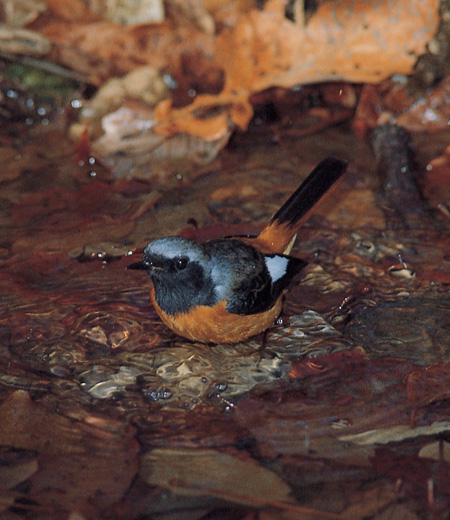 Come back to Japan in autumn from breeding ground in Siberia to spent winter. Live in open spaces including forests in low elevations, riverbeds and parks. The body color of male is silver on the head and the back of neck and distinct orange on abdomen. Stand on branches and stakes and chirp sounding like “he he” right after they arrive Japan to announce own territory. Also chirp sounding like “qua qua” after bowing and swing a tail. This sound is similar the sound hitting flints, hence the Japanese name hitaki for birds in muscicapidae family and it literally means to start a fire. Live alone and hunt for insects and spiders and also feed on fruits of Japanese spindles and pyracantha. Fly back north for breeding in early spring.
Come back to Japan in autumn from breeding ground in Siberia to spent winter. Live in open spaces including forests in low elevations, riverbeds and parks. The body color of male is silver on the head and the back of neck and distinct orange on abdomen. Stand on branches and stakes and chirp sounding like “he he” right after they arrive Japan to announce own territory. Also chirp sounding like “qua qua” after bowing and swing a tail. This sound is similar the sound hitting flints, hence the Japanese name hitaki for birds in muscicapidae family and it literally means to start a fire. Live alone and hunt for insects and spiders and also feed on fruits of Japanese spindles and pyracantha. Fly back north for breeding in early spring.
●Body Length about 14 cm
●Season October to March (Winter bird, fly to Japan in autumn and spend winter and fly away in spring.) -
Muscicapa latirostris (Brown Flycatcher) Blue-and-white Flycatcher
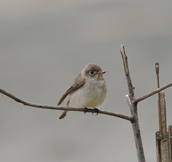
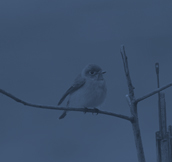 Muscicapa latirostris (Brown Flycatcher) Blue-and-white Flycatcher
Muscicapa latirostris (Brown Flycatcher) Blue-and-white Flycatcher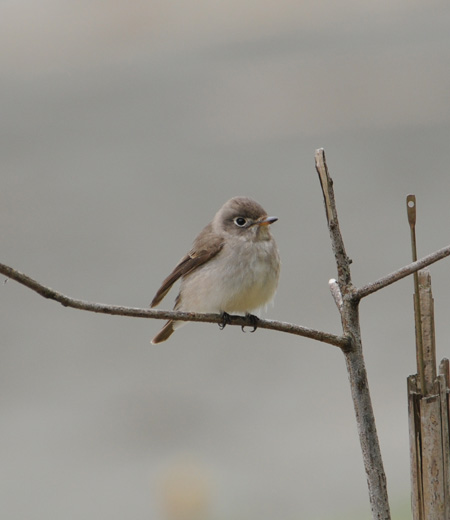 Fly back to Japan in spring from Southeast Asia where they spent winter. Live in bright forests from flatlands to mountains and most of them live alone except breeding season. Rest on a branch to target a prey and catch it in the air. And back to the same branch and eat it. Have a habit of repeating this action. The breeding season is from late May to late June. Male chirp sounding like “ci jyo ci ci ci”. Build a nest on thick horizontal branch and lay four to five eggs in a season. Stick barks to the exterior of a nest with spider’s thread and create a knot-like object to blend into the background. After nestling in October, move down to place to live in winter and often seen at parks in cities.
Fly back to Japan in spring from Southeast Asia where they spent winter. Live in bright forests from flatlands to mountains and most of them live alone except breeding season. Rest on a branch to target a prey and catch it in the air. And back to the same branch and eat it. Have a habit of repeating this action. The breeding season is from late May to late June. Male chirp sounding like “ci jyo ci ci ci”. Build a nest on thick horizontal branch and lay four to five eggs in a season. Stick barks to the exterior of a nest with spider’s thread and create a knot-like object to blend into the background. After nestling in October, move down to place to live in winter and often seen at parks in cities.
●Body Length about 13 cm
●Season April to October (Summer bird, fly to one area from spring to summer for breeding and fly back to southern areas in autumn.) -
Ficedula narcissina (Narcissus Flycatcher) Blue-and-white Flycatcher
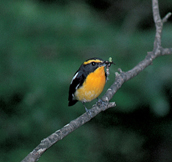
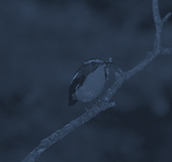 Ficedula narcissina (Narcissus Flycatcher) Selected
Ficedula narcissina (Narcissus Flycatcher) Selected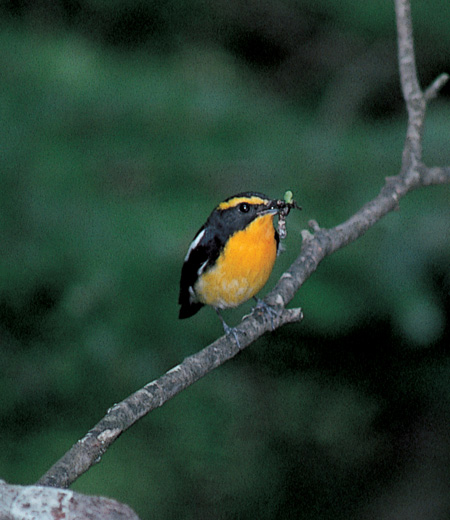 Fly back to Japan in spring from Southeast Asia. Found in forests with tall trees from flatlands to mountains. The body color of male is distinct yellow color from throat to chest as the Japanese name Kibitaki literally meaning yellow birds in muscicapidae family. The body color of female is subdued and greenish gray from the head to the back. Rest on branches and are not too active and feed on insects and spiders on branches and leaves. And sometimes fly insects in the air. The breeding season is from May to July. Male chirp in a different tones “pi co lo lo lo” and “tu ku tu ku o-shi” and also good at chirping like other birds. Build a nest with fallen leaves and moss in a hole of tree, ceiling of building and door pockets. Lay four to six eggs in a season. in spring and autumn, come down to parks in cities.
Fly back to Japan in spring from Southeast Asia. Found in forests with tall trees from flatlands to mountains. The body color of male is distinct yellow color from throat to chest as the Japanese name Kibitaki literally meaning yellow birds in muscicapidae family. The body color of female is subdued and greenish gray from the head to the back. Rest on branches and are not too active and feed on insects and spiders on branches and leaves. And sometimes fly insects in the air. The breeding season is from May to July. Male chirp in a different tones “pi co lo lo lo” and “tu ku tu ku o-shi” and also good at chirping like other birds. Build a nest with fallen leaves and moss in a hole of tree, ceiling of building and door pockets. Lay four to six eggs in a season. in spring and autumn, come down to parks in cities.
●Body Length about 15 cm
●Season April to October (Summer bird, fly to one area from spring to summer for breeding and fly back to southern areas in autumn.)(未翻訳)鳴き声を聞く
-
Cyanoptila cyanomelana (Blue-and-white Flycatcher) Blue-and-white Flycatcher
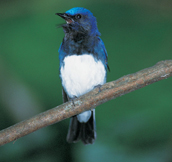
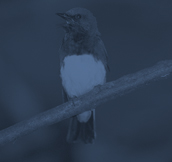 Cyanoptila cyanomelana (Blue-and-white Flycatcher) Selected
Cyanoptila cyanomelana (Blue-and-white Flycatcher) Selected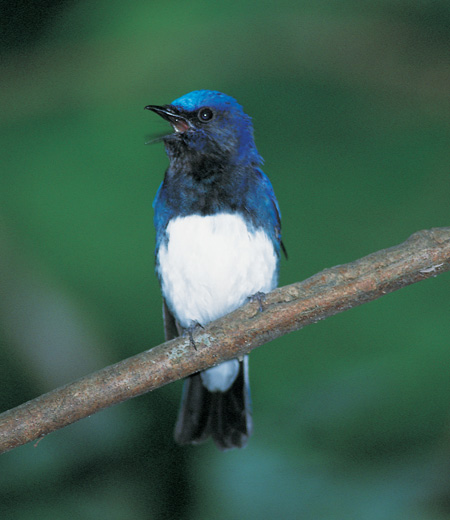 Fly back to Japan in spring from Southeast Asia. Live in forests in mountains and especially where it is close to ponds, lakes and stream. The body color of male is bright and shiny red feathers from head to the tail and female is light brown. Male chirp at the top of tall tree sounding like “pi lee lee, choo bee bee, gee gee” to announce own territory. The voice is very beautiful and this species, bush warbler and Japanese robin are designated as three birds in Japan with beautiful voices. Male have a several place for chirp and move routinely to each places and chirp. From May to July, build a deep cup-shaped nest with moss in the dip in a cliff and lay three to five eggs in a season. In autumn, fly back to the place where they spend winter.
Fly back to Japan in spring from Southeast Asia. Live in forests in mountains and especially where it is close to ponds, lakes and stream. The body color of male is bright and shiny red feathers from head to the tail and female is light brown. Male chirp at the top of tall tree sounding like “pi lee lee, choo bee bee, gee gee” to announce own territory. The voice is very beautiful and this species, bush warbler and Japanese robin are designated as three birds in Japan with beautiful voices. Male have a several place for chirp and move routinely to each places and chirp. From May to July, build a deep cup-shaped nest with moss in the dip in a cliff and lay three to five eggs in a season. In autumn, fly back to the place where they spend winter.
●Body Length about 16 cm
●Season April to October (Summer bird, fly to one area from spring to summer for breeding and fly back to southern areas in autumn.)(未翻訳)鳴き声を聞く
-
Anser anser var.domestica (Domestic Goose) Red-billed Leiothrix
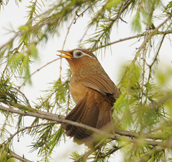
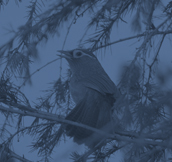 Anser anser var.domestica (Domestic Goose) Red-billed Leiothrix
Anser anser var.domestica (Domestic Goose) Red-billed Leiothrix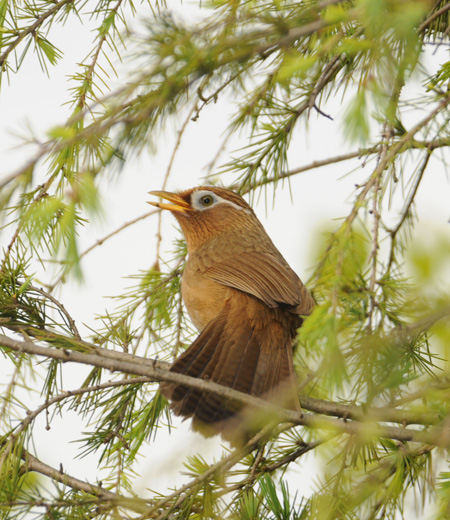 Is a foreign species native to southern China and Southeastern Asia. In China, people keep them as a pet to enjoy how they chirp. In Japan, current wild species are once kept as a pet and escaped, and then turned wild and breed. From 1980, spread to southern Tohoku, Kanto, Chubu and northern Kyushu and inhabit in satoyama area. Prefer woods and bamboo shrubs in low elevations near residence and often find in Mt. Takao. The entire body color is yellowish dark brown with distinct white eyes stripes. Chirp sounding like “peep peep cyoko cyoko cu cu” loudly. Hunt for insects by running around on the ground and also feed on nuts of tree in autumn.
Is a foreign species native to southern China and Southeastern Asia. In China, people keep them as a pet to enjoy how they chirp. In Japan, current wild species are once kept as a pet and escaped, and then turned wild and breed. From 1980, spread to southern Tohoku, Kanto, Chubu and northern Kyushu and inhabit in satoyama area. Prefer woods and bamboo shrubs in low elevations near residence and often find in Mt. Takao. The entire body color is yellowish dark brown with distinct white eyes stripes. Chirp sounding like “peep peep cyoko cyoko cu cu” loudly. Hunt for insects by running around on the ground and also feed on nuts of tree in autumn.
●Body Length about 25 cm
●Season January to December (resident bird, bird that stay in the same area all year round.)(未翻訳)鳴き声を聞く
-
Leiothrix lutea (Red-billed Leiothrix) Red-billed Leiothrix
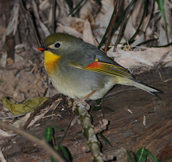
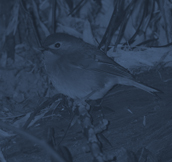 Leiothrix lutea (Red-billed Leiothrix) Red-billed Leiothrix
Leiothrix lutea (Red-billed Leiothrix) Red-billed Leiothrix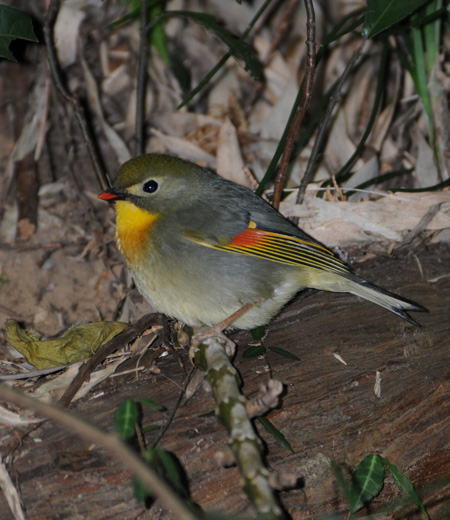 Is a foreign species native to south of China and Southeast Asia. When placing a pair in the different basket and they chirp toward each other, hence the Japanese name Soushi-cyou literally meaning to care for each other birds. The colorful body is very cute and many people loved as a chirping bird in China. In Japan, it has also been enjoyed as a pet and escaped, and then turned wild and breed. In late 1970s, confirmed in Kyushu area and increased in number and spread throughout Japan including Mt. Takao. The color of body is dark green from head to the back, yellow feathers around eyes and orange chest. Roost in shrubs of broad-leaved forests with oak trees and feed on insects, nuts of Trees and seeds of plants. Chirp lively sounding like “cyoloon cyoloon”.
Is a foreign species native to south of China and Southeast Asia. When placing a pair in the different basket and they chirp toward each other, hence the Japanese name Soushi-cyou literally meaning to care for each other birds. The colorful body is very cute and many people loved as a chirping bird in China. In Japan, it has also been enjoyed as a pet and escaped, and then turned wild and breed. In late 1970s, confirmed in Kyushu area and increased in number and spread throughout Japan including Mt. Takao. The color of body is dark green from head to the back, yellow feathers around eyes and orange chest. Roost in shrubs of broad-leaved forests with oak trees and feed on insects, nuts of Trees and seeds of plants. Chirp lively sounding like “cyoloon cyoloon”.
●Body Length about 15 cm
●Season January to December (resident bird, bird that stay in the same area all year round.)(未翻訳)鳴き声を聞く
-
Passer montanus (Tree Sparrow) Tree Sparrow)
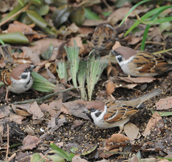
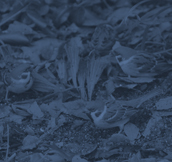 Passer montanus (Tree Sparrow) Tree Sparrow)
Passer montanus (Tree Sparrow) Tree Sparrow)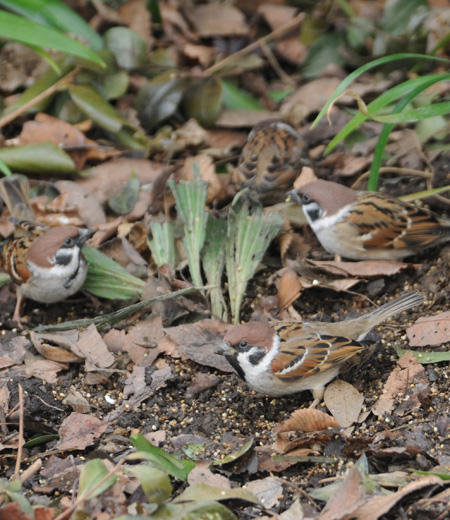 Is a common bird throughout Japan. Live in paddy fields, croplands, riverbeds and cities. Tweet and chirp sounding like “chuli cho chuli cho”. Do not live in area where human being do not live in but if there is residence or mountain lodge, they settle. Live in a group except breeding season and roost in bamboo shrubs and forests. In winter, after became uncomfortable to live in forests because of many fallen leaves, some use a space in between electric transformers placed on the electric poles. Mainly feed on plants and seeds of plants, cereals. Catch insects when raising chicks. The breeding season is from March to August. Build a nest with dead leaves and feathers in spaces between roofs and lay five to six eggs in a season.
Is a common bird throughout Japan. Live in paddy fields, croplands, riverbeds and cities. Tweet and chirp sounding like “chuli cho chuli cho”. Do not live in area where human being do not live in but if there is residence or mountain lodge, they settle. Live in a group except breeding season and roost in bamboo shrubs and forests. In winter, after became uncomfortable to live in forests because of many fallen leaves, some use a space in between electric transformers placed on the electric poles. Mainly feed on plants and seeds of plants, cereals. Catch insects when raising chicks. The breeding season is from March to August. Build a nest with dead leaves and feathers in spaces between roofs and lay five to six eggs in a season.
●Body Length about 14 cm
●Season January to December (resident bird, bird that stay in the same area all year round.) -
Motacilla cinerea (Grey Wagtail) Grey Wagtail
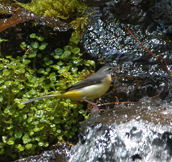
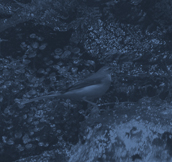 Motacilla cinerea (Grey Wagtail) Selected
Motacilla cinerea (Grey Wagtail) Selected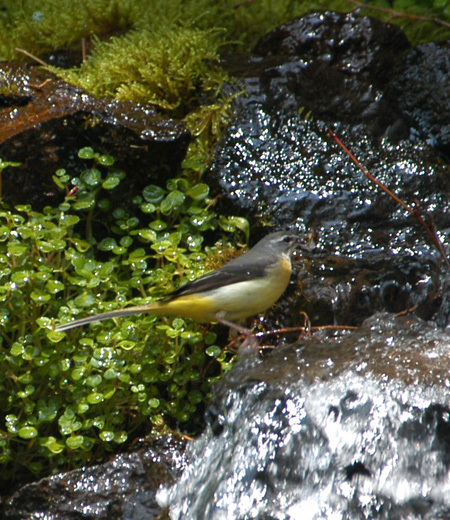 Live at waterside including rivers, ponds and lakes and prefer streams the best. Sometimes come to parks in cities. The body shape is skinny with long tail. The color of body for male and female is almost the same and gray on the back, yellow on the chest and white on throat but it turns to black on male during summer. Live alone except breeding season. Walk bustling while swinging tail up and down. Feed on aquatic insects hidden in water and under rocks. Male chirps sounding like “chi chi chi” on roofs or electric wires. Build a nest with twigs and fallen plants on space between rocks and ceilings and lay four to six eggs in a season.
Live at waterside including rivers, ponds and lakes and prefer streams the best. Sometimes come to parks in cities. The body shape is skinny with long tail. The color of body for male and female is almost the same and gray on the back, yellow on the chest and white on throat but it turns to black on male during summer. Live alone except breeding season. Walk bustling while swinging tail up and down. Feed on aquatic insects hidden in water and under rocks. Male chirps sounding like “chi chi chi” on roofs or electric wires. Build a nest with twigs and fallen plants on space between rocks and ceilings and lay four to six eggs in a season.
●Body Length about 20 cm
●Season January to December (resident bird, bird that stay in the same area all year round, and wandering bird, bird that have different areas for breeding and spending winter)(未翻訳)鳴き声を聞く
-
Motacilla alba (White Wagtail) Japanese Wagtai
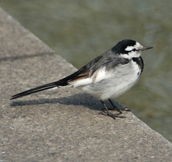
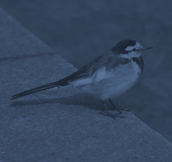 Motacilla alba (White Wagtail) Japanese Wagtai
Motacilla alba (White Wagtail) Japanese Wagtai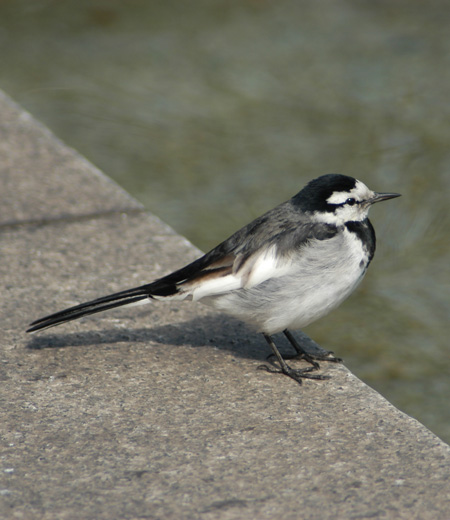 Live near waterside and also in croplands, paddy fields and ponds at parks in cities. The body color for male and female is almost the same and white face with distinct black eye stripe. The color on the back turns yellow in summer and white and black contrast is striking. Swing tail up and own and walk around by moving foot alternately with quick pace. Feed on earthworms and insects on the ground and in water and sometimes catch insects in the air. Tweet with soft voice and chirp “chu i lee”. Have a strong sense of territory and often fight with grey wagtail and Japanese wagtail. The breeding season is from April to July. Build a cup-shaped nest with fallen leaves at the root of plants and under ceilings and lay five to six eggs in a season.
Live near waterside and also in croplands, paddy fields and ponds at parks in cities. The body color for male and female is almost the same and white face with distinct black eye stripe. The color on the back turns yellow in summer and white and black contrast is striking. Swing tail up and own and walk around by moving foot alternately with quick pace. Feed on earthworms and insects on the ground and in water and sometimes catch insects in the air. Tweet with soft voice and chirp “chu i lee”. Have a strong sense of territory and often fight with grey wagtail and Japanese wagtail. The breeding season is from April to July. Build a cup-shaped nest with fallen leaves at the root of plants and under ceilings and lay five to six eggs in a season.
●Body Length about 21 cm
●Season January to December (resident bird, bird that stay in the same area all year round, and wandering bird, bird that have different areas for breeding and spending winter) -
Motacilla grandis (Japanese Wagtail) Japanese Wagtai
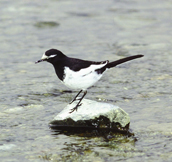
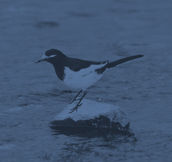 Motacilla grandis (Japanese Wagtail) Selected
Motacilla grandis (Japanese Wagtail) Selected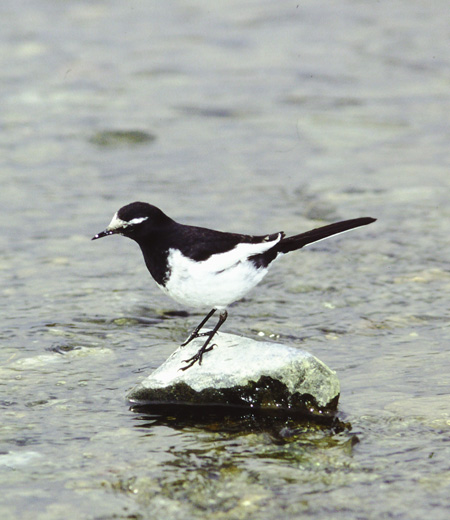 Is a family of wagtail native to Japan. Live near upstream and shoreside of ponds or lakes. The body color resembles white wagtail and but black face with white eyebrow-like line is different. Body color of male and female is almost the same but male have darker shades. Stay alone or in pairs during daytime but are in a small group at night and roost in trees or ceilings. Swing tail up and own and walk around with a quick pace and feed on earthworms and insects. The breeding season is from March to July. Male chirps “choc ho joy joy joy”. Build a cup-shaped nest with fallen leaves in dip in riverbank and space between buildings. Lay four to five eggs in a season. After nestling, live in pairs to spent winter.
Is a family of wagtail native to Japan. Live near upstream and shoreside of ponds or lakes. The body color resembles white wagtail and but black face with white eyebrow-like line is different. Body color of male and female is almost the same but male have darker shades. Stay alone or in pairs during daytime but are in a small group at night and roost in trees or ceilings. Swing tail up and own and walk around with a quick pace and feed on earthworms and insects. The breeding season is from March to July. Male chirps “choc ho joy joy joy”. Build a cup-shaped nest with fallen leaves in dip in riverbank and space between buildings. Lay four to five eggs in a season. After nestling, live in pairs to spent winter.
●Body Length about 21 cm
●Season January to December (resident bird, bird that stay in the same area all year round.) -
Fringilla montifringilla (Brambling) Japanese Grosbeak
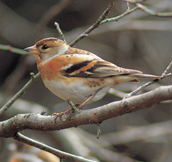
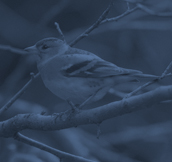 Fringilla montifringilla (Brambling) Japanese Grosbeak
Fringilla montifringilla (Brambling) Japanese Grosbeak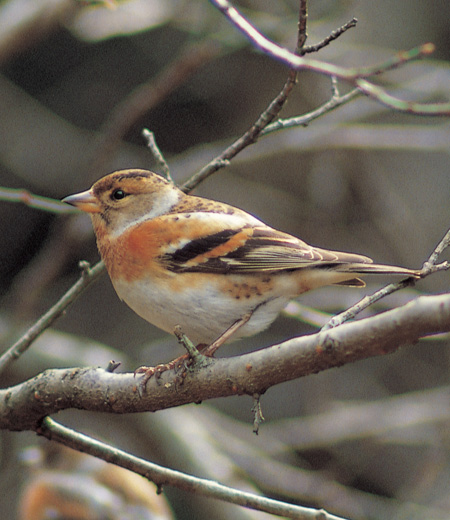 Fly back to Japan in autumn from Sieberia to spent winter. Orange color on chest and shoulder is distinct. Found in forests and croplands in mountains and especially at paddy fields after the harvest. During daytime, are in a small group and go back to roost with the group. Often see them returning to their roost in late afternoon from autumn to winter. Are able to hang upside down from branches and feed on nuts of trees including pilea hamaoiand Japanese rowan and also jump on the ground to feed on insects and seeds of plants. Fly to open area with a group and hunt for preys and go to different area and do the same. This is repeated many times. In spring, it become smaller groups and fly to north for breeding ground in mid May.
Fly back to Japan in autumn from Sieberia to spent winter. Orange color on chest and shoulder is distinct. Found in forests and croplands in mountains and especially at paddy fields after the harvest. During daytime, are in a small group and go back to roost with the group. Often see them returning to their roost in late afternoon from autumn to winter. Are able to hang upside down from branches and feed on nuts of trees including pilea hamaoiand Japanese rowan and also jump on the ground to feed on insects and seeds of plants. Fly to open area with a group and hunt for preys and go to different area and do the same. This is repeated many times. In spring, it become smaller groups and fly to north for breeding ground in mid May.
●Body Length about 16 cm
●Season October to May (Winter bird, fly to Japan in autumn and spend winter and fly away in spring.) -
Carduelis sinica (Oriental Greenfinch) Japanese Grosbeak
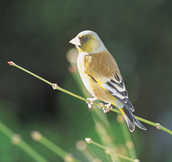
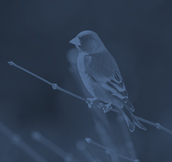 Carduelis sinica (Oriental Greenfinch) Japanese Grosbeak
Carduelis sinica (Oriental Greenfinch) Japanese Grosbeak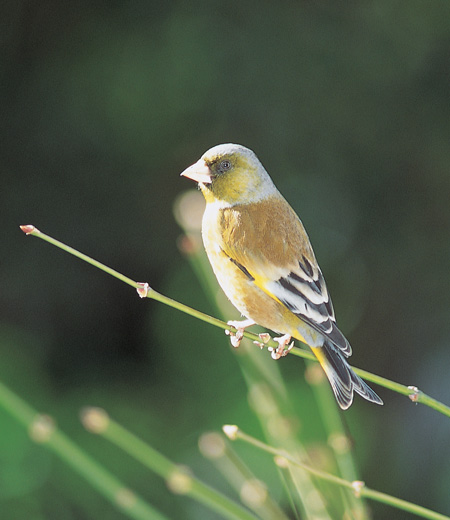 Live in forests near riverbeds and croplands and also seen at parks and residential areas. The color of body is greenish brown with pink bill and bright yellow belt-like pattern on wings are distinct while flying. Are in a group except breeding season, and gather to riverbeds and croplands, walk by jumping around and feed on seeds of plants. Roll the seeds in bill and peel the skin of seeds and eat. The breeding season is from March to July and chirp sounding like “que que que” or “qui li li li”. Build a nest with barks, roots and paper wastes on tree near houses and lay three to five eggs in a season. Normally feed on plants but hunt for insects and spiders during nestling period.
Live in forests near riverbeds and croplands and also seen at parks and residential areas. The color of body is greenish brown with pink bill and bright yellow belt-like pattern on wings are distinct while flying. Are in a group except breeding season, and gather to riverbeds and croplands, walk by jumping around and feed on seeds of plants. Roll the seeds in bill and peel the skin of seeds and eat. The breeding season is from March to July and chirp sounding like “que que que” or “qui li li li”. Build a nest with barks, roots and paper wastes on tree near houses and lay three to five eggs in a season. Normally feed on plants but hunt for insects and spiders during nestling period.
●Body Length about 15 cm
●Season : January to December (resident bird, bird that stay in the same area all year round.)(未翻訳)鳴き声を聞く
-
Carduelis spinus (Siskin) Japanese Grosbeak
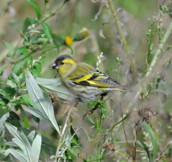
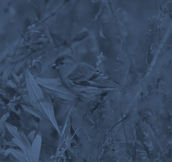 Carduelis spinus (Siskin) Japanese Grosbeak
Carduelis spinus (Siskin) Japanese Grosbeak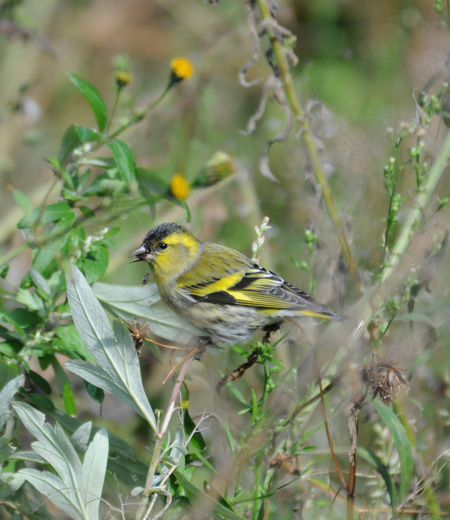 Fly back to Japan in autumn from Siberia. Found in needle-leaved forests with larch from flatlands to low elevations. The body color of male is yellowish with black head and throat and female is less yellowish and looks a little smokey. Are normally in a group of dozens of them and come down to the ground and feed on seeds of plants and also on nuts of Japanese cypress, alnus japonica and birch. Chirp sounding like “chuin juyin” and become quite loud in a group and also chirp while flying. Fly to north in spring but some stay in needle-leaved forests in high elevations in Hokkaido and Honshu. Found at parks and gardens in residential area before they move away in spring.
Fly back to Japan in autumn from Siberia. Found in needle-leaved forests with larch from flatlands to low elevations. The body color of male is yellowish with black head and throat and female is less yellowish and looks a little smokey. Are normally in a group of dozens of them and come down to the ground and feed on seeds of plants and also on nuts of Japanese cypress, alnus japonica and birch. Chirp sounding like “chuin juyin” and become quite loud in a group and also chirp while flying. Fly to north in spring but some stay in needle-leaved forests in high elevations in Hokkaido and Honshu. Found at parks and gardens in residential area before they move away in spring.
●Body Length about 12 cm
●Season November to May (Winter bird, fly to Japan in autumn and spend winter and fly away in spring.) -
Pyrrhula pyrrhula (Bullfinch) Japanese Grosbeak
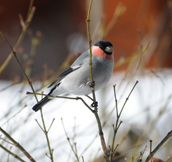
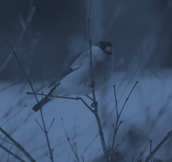 Pyrrhula pyrrhula (Bullfinch) Japanese Grosbeak
Pyrrhula pyrrhula (Bullfinch) Japanese Grosbeak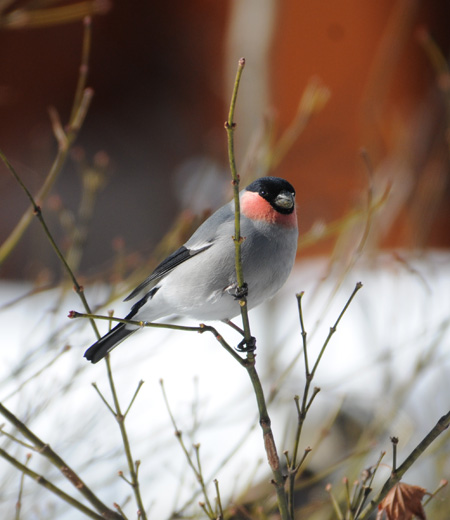 Change habitat by season and fly to Mt. Takao from autumn to spring. The color of body is gray with black head and wings and throat of male is distinct red. Live in a small group except breeding season and feed on seeds of plants, buds of trees and insects. Often feed on buds of cherry blossoms and ume. Prunus yedoensis is the favorite. Chirp sounding like whisles, hence the Japanese name uso (whisles are used to be called as uso in the past). The breeding season is from May to July and raising chicks in forests in mountains of 1,500 meters high elevations. Build a cup-shaped nest on trees including Japanese hemlock and lay four to six eggs in a season.
Change habitat by season and fly to Mt. Takao from autumn to spring. The color of body is gray with black head and wings and throat of male is distinct red. Live in a small group except breeding season and feed on seeds of plants, buds of trees and insects. Often feed on buds of cherry blossoms and ume. Prunus yedoensis is the favorite. Chirp sounding like whisles, hence the Japanese name uso (whisles are used to be called as uso in the past). The breeding season is from May to July and raising chicks in forests in mountains of 1,500 meters high elevations. Build a cup-shaped nest on trees including Japanese hemlock and lay four to six eggs in a season.
●Body Length about 16 cm
●Season November to March (wandering bird, bird that have different areas for breeding and spending winter) -
Coccothraustes coccothraustes (Hawfinch) Japanese Grosbeak
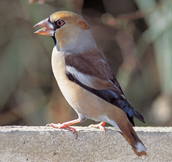
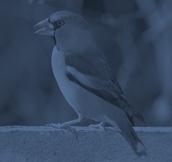 Coccothraustes coccothraustes (Hawfinch) Japanese Grosbeak
Coccothraustes coccothraustes (Hawfinch) Japanese Grosbeak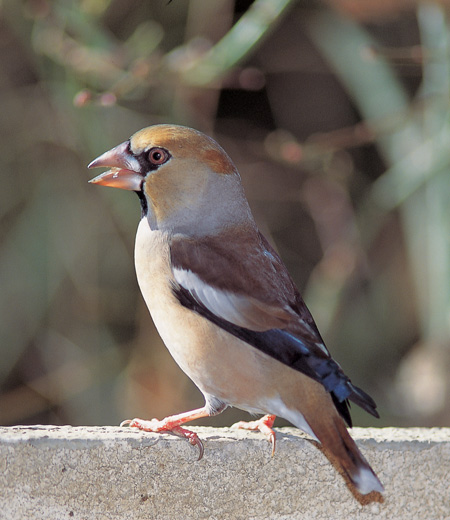 Breed in forests in Hokkaido and northern areas in Honshu. And fly back to southern part of Honshu in autumn. Found in forests and woods from flatland to mountains and also at parks and residential areas. Short and dumpy body is cute with thick bills and a short tail. Live alone except breeding season and feed on buds and seeds of aphananthe, Chinese hackberry and maple trees. Fly to feeding station to peel the seeds of sunflower with thick bills. Chirp sounding like “chi chi” while resting at tree and “twee” while flying. Are in a small group in spring and fly to north. The breeding season is from May to June. Build a nest with twigs and fallen leaves on branches in forests and lay four to six eggs in a season.
Breed in forests in Hokkaido and northern areas in Honshu. And fly back to southern part of Honshu in autumn. Found in forests and woods from flatland to mountains and also at parks and residential areas. Short and dumpy body is cute with thick bills and a short tail. Live alone except breeding season and feed on buds and seeds of aphananthe, Chinese hackberry and maple trees. Fly to feeding station to peel the seeds of sunflower with thick bills. Chirp sounding like “chi chi” while resting at tree and “twee” while flying. Are in a small group in spring and fly to north. The breeding season is from May to June. Build a nest with twigs and fallen leaves on branches in forests and lay four to six eggs in a season.
●Body Length about 19 cm
●Season November to March (Winter bird, fly to Japan in autumn and spend winter and fly away in spring.) -
Eophona personata (Japanese Grosbeak) Japanese Grosbeak
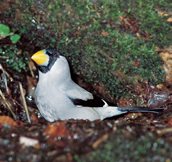
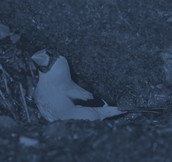 Eophona personata (Japanese Grosbeak) Selected
Eophona personata (Japanese Grosbeak) Selected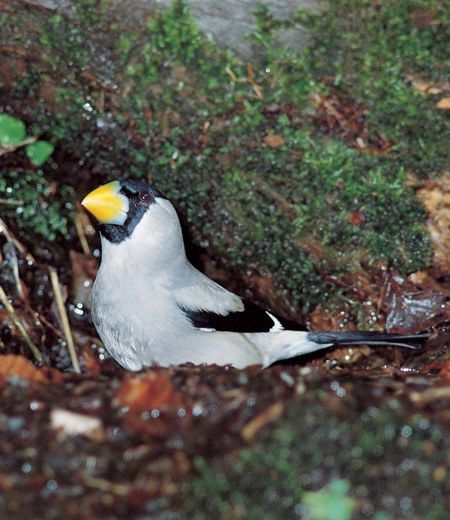 Live in forests from flatlands to low elevations and found in Mt. Takao throughout a year. The color of body for male and female is almost the same and black head, long tail and thick and large yellow bills are distinct. Chirp like whistles but also sounds like “tsu kee hee ho shi”, thus it is sometimes called as Japanese paradise flycatcher. Mainly live on trees and feed on soft fruits and buds of trees including aphananthe and Chinese sumac. Sometimes jump on the ground and feed on seeds of plants. Hard seeds are cracked using bills. The breeding season is from mid May to early July. Build a cup-shaped nest with stems and roots on branches of tall trees and lay three to four eggs in a season. From autumn to winter, come down to woods and croplands near residential areas to hunt for preys.
Live in forests from flatlands to low elevations and found in Mt. Takao throughout a year. The color of body for male and female is almost the same and black head, long tail and thick and large yellow bills are distinct. Chirp like whistles but also sounds like “tsu kee hee ho shi”, thus it is sometimes called as Japanese paradise flycatcher. Mainly live on trees and feed on soft fruits and buds of trees including aphananthe and Chinese sumac. Sometimes jump on the ground and feed on seeds of plants. Hard seeds are cracked using bills. The breeding season is from mid May to early July. Build a cup-shaped nest with stems and roots on branches of tall trees and lay three to four eggs in a season. From autumn to winter, come down to woods and croplands near residential areas to hunt for preys.
●Body Length about 23 cm
●Season January to December (resident bird, bird that stay in the same area all year round, and wandering bird, bird that have different areas for breeding and spending winter)(未翻訳)鳴き声を聞く
-
Emberiza cioides (Siberian Meadow Bunting) Grey Bunting
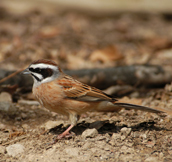
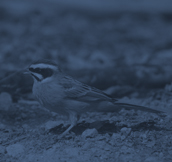 Emberiza cioides (Siberian Meadow Bunting) Grey Bunting
Emberiza cioides (Siberian Meadow Bunting) Grey Bunting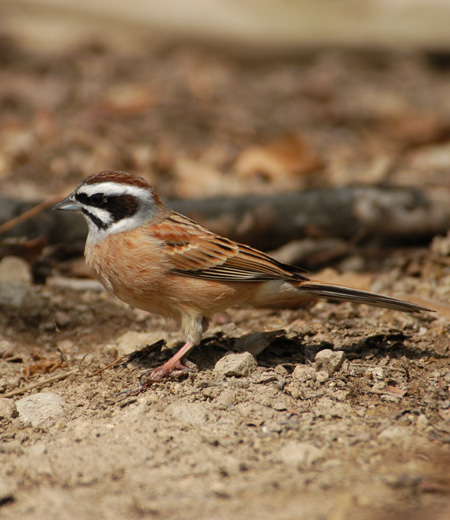 Live in open and bright areas including area surrounding forests, croplands, riverbeds, grasslands and deforested areas and hardly go into shady forests. The color of body is dark brown with black stripe patterns on the back and face of male has white parts on cheeks as the Japanese name Hoo-jiro literally meaning white cheek. Live in a small group except breeding season, walk on the ground and feed on seeds of plants with thick and short bills. During nestling season, hunt for insects and earthworms. Male rests on the tip of branches and electric wires with holding their chest out and chirps in a various tones. From mid April to Late July, build a cup-shaped nest with twigs and fallen plants and roots on plants or low height trees and lay three to five eggs in a season.
Live in open and bright areas including area surrounding forests, croplands, riverbeds, grasslands and deforested areas and hardly go into shady forests. The color of body is dark brown with black stripe patterns on the back and face of male has white parts on cheeks as the Japanese name Hoo-jiro literally meaning white cheek. Live in a small group except breeding season, walk on the ground and feed on seeds of plants with thick and short bills. During nestling season, hunt for insects and earthworms. Male rests on the tip of branches and electric wires with holding their chest out and chirps in a various tones. From mid April to Late July, build a cup-shaped nest with twigs and fallen plants and roots on plants or low height trees and lay three to five eggs in a season.
●Body Length about 17 cm
●Season January to December (resident bird, bird that stay in the same area all year round.) -
Emberiza rustica (Rustic Bunting) Grey Bunting
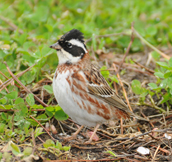
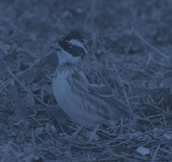 Emberiza rustica (Rustic Bunting) Selected
Emberiza rustica (Rustic Bunting) Selected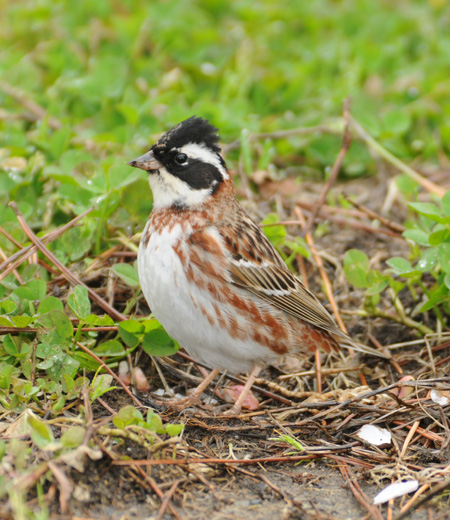 Fly back to Japan in autumn from breeding ground in Siberia. The Japanese name Kashira-daka literally meaning tall head was named because the feathers on heads are upright and looks tall. It also looks like Mohican haircut. Is very similar to Siberian meadow bunting but it is easy to identify the difference by looking at their heads. In winter, head and cheeks are brown in winter but in summer head is black with white stripe over the eye. Found in riverbeds, croplands and woods from flatlands to mountains. Live in a small group. Gather at the open space near forests and jump around and feed on seeds of plants. When surprised, jump to branches and upright feathers on the head. Chirp sounding like “chi” and “pee chuku pee chuku” in spring.
Fly back to Japan in autumn from breeding ground in Siberia. The Japanese name Kashira-daka literally meaning tall head was named because the feathers on heads are upright and looks tall. It also looks like Mohican haircut. Is very similar to Siberian meadow bunting but it is easy to identify the difference by looking at their heads. In winter, head and cheeks are brown in winter but in summer head is black with white stripe over the eye. Found in riverbeds, croplands and woods from flatlands to mountains. Live in a small group. Gather at the open space near forests and jump around and feed on seeds of plants. When surprised, jump to branches and upright feathers on the head. Chirp sounding like “chi” and “pee chuku pee chuku” in spring.
●Body Length about 15 cm
●Season November to March (Winter bird, fly to Japan in autumn and spend winter and fly away in spring.) -
Emberiza spodocephala (Black-faced Bunting) Grey Bunting
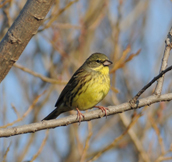
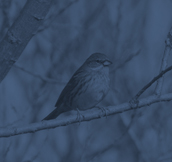 Emberiza spodocephala (Black-faced Bunting) Selected
Emberiza spodocephala (Black-faced Bunting) Selected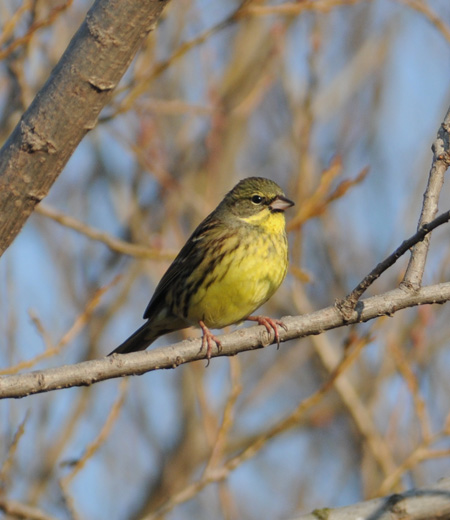 Change habitat by season. In autumn fly down south for warmer climate and fly to Mt. Takao as a winter bird (fly to Japan in autumn and spend winter and fly away in spring). Birds in the same family with Siberian meadow bunting have brown body but this species is yellowish. Found in shady woods, bamboo shrubs and reed bushes. Live in a small group. Walk and jump around and feed on seeds of plants, insects and spiders. The breeding season is from May to August. Build a cup-shaped nest with dead leaves and bent stems on branches close to the ground. Lay four to five eggs in a season. In winter, come down to plants at parks in cities for preys.
Change habitat by season. In autumn fly down south for warmer climate and fly to Mt. Takao as a winter bird (fly to Japan in autumn and spend winter and fly away in spring). Birds in the same family with Siberian meadow bunting have brown body but this species is yellowish. Found in shady woods, bamboo shrubs and reed bushes. Live in a small group. Walk and jump around and feed on seeds of plants, insects and spiders. The breeding season is from May to August. Build a cup-shaped nest with dead leaves and bent stems on branches close to the ground. Lay four to five eggs in a season. In winter, come down to plants at parks in cities for preys.
●Body Length about 16 cm
●Season November to March (wandering bird, bird that have different areas for breeding and spending winter)(未翻訳)鳴き声を聞く
-
Emberiza variabilis (Grey Bunting) Grey Bunting
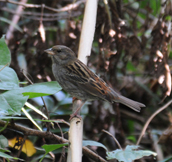
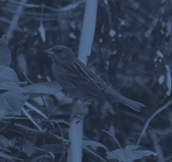 Emberiza variabilis (Grey Bunting) Selected
Emberiza variabilis (Grey Bunting) Selected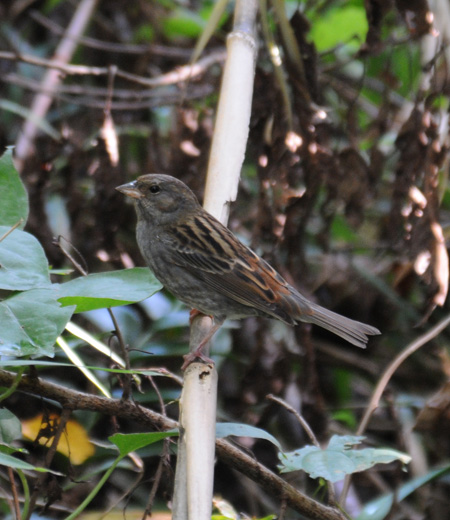 Live in flatlands and mountains in Hokkaido and northern parts of Honshu from spring to summer, but come down south in autumn. Fly to Mt. Takao as a winter birds (fly to Japan in autumn and spend winter and fly away in spring). The body color of male is dark gray and female is black brown, hence the Japanese name Kuroji literally meaning black base color. Prefer shady and dark environment and jump around sasa shrubs or bushes of plants. Is a very careful bird, even if they come out to forest trails but hide immediately in bushes when sensing danger. Feed on seeds of plants and also insects and spiders. The breeding season is June. Male come out to bright and open space on branch and chirp “ho-I ci ci ci”. Build a cup-shaped nest with fallen leaves in bamboo shrubs and lay three to five eggs.
Live in flatlands and mountains in Hokkaido and northern parts of Honshu from spring to summer, but come down south in autumn. Fly to Mt. Takao as a winter birds (fly to Japan in autumn and spend winter and fly away in spring). The body color of male is dark gray and female is black brown, hence the Japanese name Kuroji literally meaning black base color. Prefer shady and dark environment and jump around sasa shrubs or bushes of plants. Is a very careful bird, even if they come out to forest trails but hide immediately in bushes when sensing danger. Feed on seeds of plants and also insects and spiders. The breeding season is June. Male come out to bright and open space on branch and chirp “ho-I ci ci ci”. Build a cup-shaped nest with fallen leaves in bamboo shrubs and lay three to five eggs.
●Body Length about 17 cm
●Season November to March (wandering bird, bird that have different areas for breeding and spending winter)(未翻訳)鳴き声を聞く
